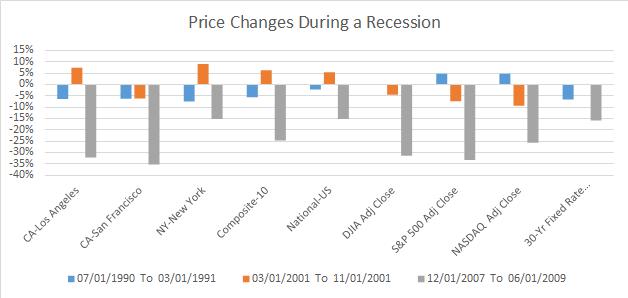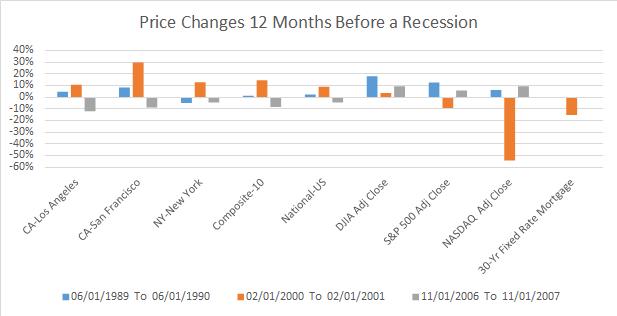![]() RealTMOR Asset Mgmt LLC and RealTMOR Apartment Mgmt LLP
RealTMOR Asset Mgmt LLC and RealTMOR Apartment Mgmt LLP
Three main recession periods analyzed:
-
Post-Gulf War Recession: July 1990 to March 1991
-
Dot Com Crash: March 2001 to November 2001
-
Real Estate Crash / Global Financial Crisis: December 2007 to June 2009
The Post-Gulf War recession (90’s Recession) was preceded by high interest rates (and high mortgage rates) and high consumer debt. The dot com crash severely impacted the NASDAQ, the technology sector and San Francisco real estate. The effects to other asset classes was more muted. The real estate crash which preceded the global financial crisis actually started with “bursting of the real estate bubble” and then impacting majority of the asset classes. The effects of the recession was felt globally.
Observations:
During the 90’s Recession, real estate prices were negatively impacted (down moves in prices was below 10%) in most of the US. Growth rates of US real estate prices had slowed down, albeit still showed positive growth rates, about 12 months prior to the recession. But growth rates of real estate prices in New York was negative during the 12 month period preceding the recession. 12 months after the recession, real estate prices recovered and growth rates were positive but highly anaemic.
The stock indexes were very mildly positive during this recession (DJIA was flat). The indexes were in positive territory both prior to and post the recession. Mortgage rates came down during the recession, one of the factors that was blamed for this recession was high interest rates (from prior interest rate hikes). Interest rates and mortgage rates kept falling over the twelve month period after this recession ended.
During the Dot Com Crash, real estate prices were growing and remained positive in most of the US except San Francisco. San Francisco and Silicon Valley is the heart of the global technology industry and hence its real estate prices felt the negative impact of the crash in technology stocks. Real estate prices in San Francisco were down but it wasn’t very long drawn out nor was the fall severe. US real estate prices were growing at a good clip about 12 months prior to the recession. Real estate prices in San Francisco grew strongly during the 12 month period preceding the recession and outperformed most of the country. 12 months after the recession, real estate prices recovered and the growth rates were strongly positive even in San Francisco (although price growth in San Francisco during this period was slower than in other cities).
The stock indexes took a tumble during this recession especially the technology heavy NASDAQ. The indexes were in negative territory both prior to and post the recession. The technology heavy NASDAQ was down about 50% in the 12 month period prior to the recession and about 30% lower in the 12 month period post the recession. The main factor blamed for this recession was sky-high valuation in technology stocks (technology/internet stock bubble). Mortgage rates were flat during the recession. Interest rates and mortgage rates kept falling over the 12 month period before and after this recession. Part of this was due to government intervention.
During the recession caused by a crash in real estate prices followed by the global financial crisis, real estate prices were severely negatively impacted (down moves in prices was almost 50%+ in some Tier 3 markets) in most of the US. Even Tier 1 cities had significant price erosion, NYC held up the best during this time with prices going down around 15% or so. Till 2005-2006, growth rates of US real estate prices had been moving up at a blistering pace and many commentators believed that there was a “real estate bubble” in the country. 12 months prior to the recession, real estate prices had started deflating. 12 months after the recession, real estate prices still remained in negative territory or flat in most markets except in San Francisco where there was a weak positive trend. The real recovery in real estate prices started only around 2011-12.
The stock indexes were significantly down during this recession (around 30%). There was significant turmoil in the stock markets at this time and the US Government had to institute many measures (TARP etc) to provide financial assistance to the economy/companies (banks, auto companies, Fannie/ Freddie etc.). The indexes were in mildly positive territory both 12-months prior to and post the recession. Mortgage rates came down during the recession and were held down through major government intervention. Interest rates and mortgage rates kept falling over the 12 month period after this recession ended. The Fed embarked on QE and slashed interest rates to near zero. This was done to stimulate the economy post the global financial crisis. Since then, interest rates have been very low and hence mortgage rates have been at historic lows.
Conclusion:
Currently (2019), there isn’t a sign of a recession but the real estate markets seem to have moved ahead of themselves. Although, they don’t seem to be in “bubble” territory. The prices in most markets are close to or above 2005-2006 highs. But prices are moving downwards in NYC. If there is a recession in the next 12+ months, it seems it could resemble the 90’s Recession. Hence, one could consider buying real estate assets, but carefully, and only those that are priced RIGHT to provide an appropriate yield should prices turn south.
Performance of Various Asset Classes Around A Recession



